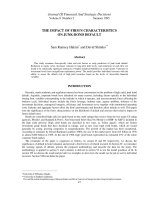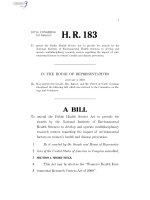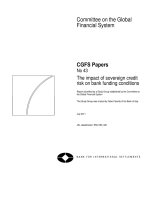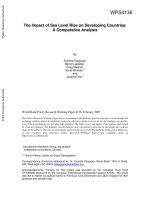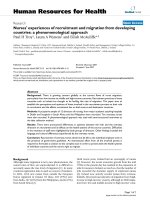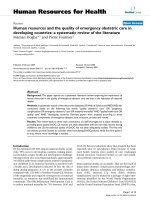The Impact of Sea Level Rise on Developing Countries: A Comparative Analysis pdf
Bạn đang xem bản rút gọn của tài liệu. Xem và tải ngay bản đầy đủ của tài liệu tại đây (1.33 MB, 51 trang )
The Impact of Sea Level Rise on Developing Countries:
A Comparative Analysis
By
Susmita Dasgupta
*
Benoit Laplante
**
Craig Meisner
*
David Wheeler
***
and
Jianping Yan
**
World Bank Policy Research Working Paper 4136, February 2007
The Policy Research Working Paper Series disseminates the findings of work in progress to encourage the
exchange of ideas about development issues. An objective of the series is to get the findings out quickly,
even if the presentations are less than fully polished. The papers carry the names of the authors and should
be cited accordingly. The findings, interpretations, and conclusions expressed in this paper are entirely
those of the authors. They do not necessarily represent the view of the World Bank, its Executive Directors,
or the countries they represent. Policy Research Working Papers are available online at
.
*
Development Research Group, World Bank.
**
Independent consultants, Canada.
*** Senior Fellow, Center for Global Development
Correspondence should be addressed to: Dr. Susmita Dasgupta, World Bank, 1818 H Street,
NW, Washington, DC 20433,
.
Acknowledgements: Funding for this project was provided by the Canadian Trust Fund
(TF030569) sponsored by the Canadian International Development Agency (CIDA). We would
also like to extend our special thanks to Piet Buys, Uwe Deichmann and Jillian Kingston for their
guidance and valuable help.
WPS4136
Public Disclosure AuthorizedPublic Disclosure AuthorizedPublic Disclosure AuthorizedPublic Disclosure Authorized
2
Abstract
Sea level rise (SLR) due to climate change is a serious global threat: The scientific
evidence is now overwhelming
. Continued growth of greenhouse gas emissions and
associated global warming could well promote SLR of 1m-3m in this century, and
unexpectedly rapid breakup of the Greenland and West Antarctic ice sheets might
produce a 5m SLR. In this paper, we have assessed the consequences of continued
SLR for 84 developing countries. Geographic Information System (GIS) software has
been used to overlay the best available, spatially-disaggregated global
data on critical
impact elements (land, population, agriculture, urban extent, wetlands, and GDP) with
the inundation zones projected for 1-5m SLR. Our results reveal that hundreds of
millions of people in the developing world are likely to be displaced by SLR within this
century; and accompanying economic and ecological damage will be severe for many.
At the country level, results are extremely skewed, with severe impacts limited to a
relatively small number of countries. For these countries (e.g., Vietnam, A.R. of Egypt,
and The Bahamas), however, the consequences of SLR are potentially catastrophic.
For many others, including some of the largest (e.g., China), the absolute magnitudes of
potential impacts are very large. At the other extreme, many developing countries
experience limited impacts. Among regions, East Asia and Middle East/North Africa
exhibit the greatest relative impacts. To date, there is little evidence that the
international community has seriously considered the implications of SLR for population
location and infrastructure planning in developing countries. We hope that the
information provided in this paper will encourage immediate planning for adaptation.
3
I. Introduction
As noted by the International Panel on Climate Change (IPCC, 2001b), climate change
will have many negative effects, including greater frequency of heat waves; increased
intensity of storms, floods and droughts; rising sea levels; a more rapid spread of
disease; and loss of biodiversity. Sea level rise (SLR) poses a particular threat to
countries with heavy concentrations of population and economic activity in coastal
regions.
Until recently, studies of SLR typically predicted a 0-1 meter rise during the 21
st
century
(Church et al. 2001, IPCC Third Assessment, 2001). The three primary contributing
factors have been cited as: (i) ocean thermal expansion; (ii) glacial melt from Greenland
and Antarctica (plus a smaller contribution from other ice sheets); and (iii) change in
terrestrial storage. Among these, ocean thermal expansion was expected to be the
dominating factor behind the rise in sea level. However, new data on rates of
deglaciation in Greenland and Antarctica suggest greater significance for glacial melt,
and a possible revision of the upper-bound estimate for SLR in this century. Since the
Greenland and Antarctic ice sheets contain enough water to raise the sea level by
almost 70 m (Table 1), small changes in their volume would have a significant effect.
1
Table 1: Physical characteristics of ice on Earth.
Glaciers Ice caps
Glaciers and
ice caps *
Greenland
ice sheet
Antarctic ice
sheet
Number > 160,000 70
Area (10
6
km
2
) 0.43 0.24 0.68 1.71 12.37
Volume (10
6
km
3
) 0.08 0.10 0.18 ± 0.04 2.85 25.71
Sea-level rise equivalent (m) 0.24 0.27 0.50 ± 0.10 7.2 61.1
Accumulation
(sea-level equivalent, mm/yr)
1.9 ± 0.3 1.4 ± 0.1 5.1 ± 0.2
Source: Church et al. (2001), Table 11.3
Data sources: Meier and Bahr (1996), Warrick et al. (1996), Reeh et al. (1999), Huybrechts et al. (2000).
* - does not include Greenland and Antarctic ice sheets (represented in the next columns)
Since the IPCC Third Assessment Report in 2001, there has been an increased effort to
improve measures of mass loss for the Greenland ice sheet and its contribution to SLR.
Using satellite interferometry observations, Ringot and Kanagaratnam (2006) detected
widespread glacier flow acceleration in the lower latitudes between 1996 and 2000, and
rapid extension to higher latitudes by 2005. When combined with surface loss estimates
1
If the Greenland ice sheet were to melt completely, it would raise average sea level by
approximately 7 meters (Church et al. 2001).
4
by Hanna et al. (2005), they calculated a total loss double that in the previous decade.
Comparing this rate of contribution of Greenland’s ice sheet to SLR with the IPCC
estimate for the 20
th
century, the new measures are roughly two to five times greater. In
another study of mass loss for Greenland using repeat altimetry, Krabill et al. (2004)
found that between 1993-1994 and 1998-1999, the ice sheet was losing 54 ± 14
gigatons of ice per year (Gt/yr). In contrast, net mass loss over the 1997-2003 interval
averaged 74 ± 11 Gt/yr. At these rates of net mass loss, the contribution of the
Greenland ice sheet to SLR is roughly double the rate assumed in the IPCC Third
Assessment (2001) report
2
.
In Antarctica, using the Gravity Recovery and Climate Experiment (GRACE) satellites,
Velicogna and Wahr (2006) have determined mass variations of the entire Antarctic ice
sheet during 2002-2005.
3
Their results indicate that the mass of the ice sheet decreased
significantly, at a rate of 152 ± 80 cubic kilometers of ice per year; most of this loss came
from the West Antarctic ice sheet (WAIS). This rate is several times greater than that
assumed in the IPCC Third Assessment, and the IPCC admitted that its final estimate
did not take into account the dynamic changes in the WAIS. Increasing concern also
attaches to the stability of the WAIS, which currently rests on bedrock below sea level.
Mercer (1978) speculated that human-induced global warming could cause the WAIS to
be released into the ocean by a sliding mechanism (also referred to as WAIS collapse).
This would cause a rapid rise in sea level, since it would be triggered solely through a
displacement of the WAIS without its having to melt. Were the WAIS to collapse, it would
raise average sea level by approximately 5 to 6 meters (Tol et al., 2006).
While there remains considerable uncertainty about the above scenarios, and the time
horizon over which they may unfold, recent research and expert opinion indicate that
significant SLR may occur earlier than previously thought.
4
This has prompted a number
of researchers to model the estimated impact of significant increases in SLR (these are
sometimes termed ‘extreme climate scenarios’). A number of studies have provided
estimates of the potential impacts for specific developed countries (e.g. France, the
2
360 gigatons of ice correspond approximately to 1 mm of sea level.
3
The GRACE result for total Antarctic ice mass change includes complete contributions from
such regions as the EAIS coastline and the circular cap south of 82°S, which has not been
completely surveyed with other techniques.
4
See Vaughan and Spouge, 2002.
5
Netherlands, Poland, Singapore and the United States)
5
; developing countries (e.g.
Bangladesh, Benin, China, Nigeria, and Senegal)
6
; or specific areas of individual
countries (e.g. deltas of the Nile and Bengal; Rhine Delta, Thames Estuary and Rhone
Delta)
7
. Only a limited number of studies have assessed the impacts of SLR on a
broader regional or world scale. Such studies include: Darwin and Tol (1999),
Hoozemans et al. (1993), Nicholls and Mimura (1998), Nicholls et al. (2004), Nicholls
and Lowe (2006), and Nicholls and Tol (2006). Some of these studies examine the
impact of ‘extreme climate scenarios’ such as a 5 meter SLR (e.g. Nicholls et al., 2004).
However, while indicators of impacts generally include land loss, population affected,
capital loss value and wetlands loss, different studies have used different subsets of
indicators or regions, making it difficult to compare the relative magnitude of impacts
across countries or regions.
8
This paper provides a broader comparison, by assessing the impacts of SLR for all
developing countries using a homogeneous set of indicators, and for multiple SLR
scenarios. To our knowledge, this is the first such exercise. Mendelsohn et al. (2006)
provide complementary evidence, by examining the market impacts of climate change
on rich and poor countries for a number of different climate scenarios. However, their
work does not assess the impact of SLR on multiple physical and economic indicators.
For this study, we group 84 coastal developing countries into 5 regions (corresponding
to the 5 regional departments of the World Bank):
9
Latin America and the Caribbean (25
countries); Middle East and North Africa (13); Sub-Saharan Africa (29); East Asia (13);
and South Asia (4). For each country and region, we assess the impact of SLR using
the following 6 indicators: land, population, gross domestic product (GDP), urban extent,
agricultural extent, and wetlands. Finally, these impacts are calculated for SLR scenarios
ranging from 1 to 5 meters.
5
See Baarse et al. (1994), Bijlsma et al. (1996), Mendelsohn and Neumann (1999), Ng and
Mendelsohn (2005), Olsthoorn et al. (2002), and Zeidler (1997).
6
Adam (1995), Dennis et al. (1995), French et al. (1995), Han et al. (1995), and Warrick et al.
(1996).
7
Tol et al. (2005), Yim (1995).
8
For example, the regional assessments presented in Nicholls and Mimura (1998) cover four
regions: Europe; West Africa; South, South-East, and East Asia; and the Pacific Small Islands. It
does not include Latin America and the Caribbean or other regions of Africa.
9
Hoozemans et al. (1993) divided the globe (including developed countries) into 20 regions.
6
At the outset, we acknowledge that this analysis has limitations. First, we do not assess
the likelihood of alternative SLR scenarios. We take each scenario as given, and assess
the impacts using our 6 indicators for each of the 84 developing countries and 5 regions.
Second, we assess the impacts of SLR using existing populations, socio-economic
conditions and patterns of land use, rather than attempting to predict their future states.
Since human activity is generally increasing more rapidly in coastal areas, our approach
undoubtedly underestimates the future impacts of SLR in most cases. This
underestimation will be greatest for SLR impacts on population and GDP in absolute
terms (number of people impacted or $ of GDP impacted), Third, our study is
conservative because we do not consider storm surge augmentation. Even a small
increase in sea level can significantly magnify the impact of storm surges, which occur
regularly and with devastating consequences in some coastal areas.
Despite these limitations, we believe that our comprehensive baseline estimates of SLR
impacts can assist policymakers and international development institutions in allocating
resources for adaptation to climate change. In particular, we believe that our specific
estimates, based on existing coastal conditions, are more likely to interest decision-
makers than estimates based on projections of future coastal population, economic
activity, etc.
In the next section, we describe the methodology and data sources used to estimate the
impact of SLR in developing countries. We present our results in Section III, at the
global, regional and country levels. Section IV provides a summary and conclusions.
II. Methodology and data sources
II.1 Data Sources
We employed geographic information system (GIS) software to overlay the critical
impact elements (land, population, agriculture, urban extent, wetlands, and GDP) with
the inundation zones projected for 1-5 m. SLR. We used the best available, spatially-
disaggregated data sets from various public sources, including the Center for
Environmental Systems Research (CESR), the Center for International Earth Science
Information Network (CIESIN), the International Centre for Tropical Agriculture (CIAT),
7
the International Food Policy Research Institute (IFPRI), the National Aeronautics and
Space Administration (NASA), the National Oceanographic and Atmospheric
Administration (NOAA), and the World Bank. Table 2 summarizes the data sources for
assessments of inundation zones and impacts.
Table 2
Summary of Data Sources
Dimension Dataset
Name
Unit Resolution Source(s)
Coastline and
country
boundary
WVS 1:250,000 NOAA/NASA
Elevation SRTM 90m
DEM V2
km
2
90m CIAT
Population GPW-3 Population
counts
1km CIESIN
Economic
activity
GDP2000 million US
dollars
5km World Bank, based on
Sachs et al. (2001)
Urban extent GRUMP V1 km
2
1km CIESIN
Agricultural
extent
GAE-2 km
2
1km IFPRI
Wetlands GLWD-3 km
2
1km CESR, Lehner, B. and
Döll, P. (2004)
II.2 Methodology
The country indicator database was developed by following the six-step procedure
described below.
II.2.1 Preparing country boundaries and coastlines
Country coastlines were built by sub-setting polygons from the World Vector Shoreline
(polygon), a standard National Geospatial Intelligence Agency (formerly Defense
Mapping Agency) product at a nominal scale of 1:250,000. It contains worldwide
coverage of shorelines and international boundaries. The subset country coastlines were
also used as a mask for calculating country totals for the selected exposure indicators.
8
II.2.2 Building coastal terrain models (DTM)
Coastal terrain models were derived from the CIAT SRTM 90 meters digital elevation
model (DEM) data (Version 2), released in 2005.
10
Zipped data files were downloaded
from the CIAT website, and then converted into raster format, and mosaiced in terms of
country boundaries in the ArcGIS environment.
II.2.3 Identifying inundation zones
Inundation zones were derived from the coastal terrain model (DTM) by setting the value
of pixels in the DTM to 1 for the different SLR scenarios examined in this study. Pixels
that are apparently not connected to coastlines, such as inland wetlands and lakes, were
masked out manually.
II.2.4 Calculating exposure indicators
Estimates for each indicator were calculated by overlaying the inundation zone with the
appropriate exposure surface dataset (land area, GDP, population, urban extent,
agriculture extent, and wetland). Exposure surface data were collected from various
public sources. Unless otherwise indicated, latitude and longitude are specified in
decimal degrees. The horizontal datum used is the World Geodetic System 1984 (WGS
1984). For area calculation, all units are projected to World Equal Area.
For the exposure grid surfaces, two GIS models were built for calculating the exposed
value. Because the values of the pixels in GDP and population surfaces are respectively
in millions of US dollars and number of people, the exposure is calculated by multiplying
the exposure surface with the inundation zone and then summing up by multiplying grid
count and value. Exposure indicators, such as land surface, urban extent, agriculture
extent and wetland are measured in square kilometers.
II.2.5 Adjusting absolute exposure indicators
For exposure indicators such as land area, population and GDP, which have measured
country totals available, the exposed value is adjusted to reflect its real value by using
the following formula:
10
Shuttle Radar Topographic Mission.
9
cal
cal
mea
adj
V
CT
CT
V ⋅=
where
V
adj
– Exposed value adjusted;
V
cal
– Exposed value calculated from exposure grid surfaces;
CT
mea
– Country total obtained based on statistics;
CT
cal
– Country total calculated from exposure grid surface.
II.2.6 Conducting data quality assurance and control
Quality control was conducted to adjust for errors caused by overlaying grid surfaces of
different resolutions, such as the 90-meter resolution inundation zone with 1-kilometer or
5-kilometer exposure grid surfaces. The following procedure was employed:
1) Calculate the country total from the grid surface using the country boundary;
2) Calculate the aspect exposure that is under 5-meter SLR;
3) Calculate the aspect exposure that is over 5-meter SLR;
4) Compare the country total with the sum of both aspect exposures. If the
difference is less that 5%, the calculated aspect exposure was considered within
the error tolerance. If not, the exposure calculation was reviewed and estimates
revised until the 5% difference threshold was reached.
A more detailed description of each dataset is provided in Appendix 1.
III. Results
In the first sub-section below, we present results at the global level for the 84 developing
countries included in this analysis. In sub-section III.2, we present the results for each of
the 5 regions and, individually, for each of the 84 countries. Our results indicate that for a
number of countries, even a 1-meter SLR would have a very significant impact.
III.1 Global results
Table 3 indicates that approximately 0.3% (194,000 km
2
) of the territory of the 84
developing countries would be impacted by a 1-meter SLR. This would increase to 1.2%
10
in a 5m SLR scenario. Though this remains relatively small in percentage terms,
approximately 56 million people (or 1.28% of the population) of these countries would be
impacted under a 1m SLR scenario. This would increase to 89 million people for 2m
SLR (2.03%), and 245 million people (5.57%) for 5m SLR. The impact of SLR on GDP
is slightly larger than the impact on population, because GDP per capita is generally
above average for coastal populations and cities. Wetlands would experience significant
impact even with a 1m SLR. Up to 7.3% of wetlands in the 84 countries would be
impacted by a 5m SLR.
As shown in the next section, these impacts are not uniformly distributed across the
regions and countries of the developing world. The impacts are particularly severe in a
limited number of countries.
Table 3
Impacts of sea level rise: Global level
1m 2m 3m 4m 5m
Area (Total = 63,332,530 sq. km.)
Impacted area
194,309 305,036 449,428 608,239 768,804
% of total area
0.31 0.48 0.71 0.96 1.21
Population (Total = 4,414,030,000)
Impacted population
56,344,110 89,640,441 133,049,836 183,467,312 245,904,401
% of total population
1.28 2.03 3.01 4.16 5.57
GDP (Total = 16,890,948 million USD)
Impacted GDP (USD)
219,181 357,401 541,744 789,569 1,022,349
% of total GDP
1.30 2.12 3.21 4.67 6.05
Urban extent (Total = 1,434,712 sq. km.)
Impacted area
14,646 23,497 35,794 50,742 67,140
% of total area
1.02 1.64 2.49 3.54 4.68
Agricultural extent (Total = 17,975,807 sq. km.)
Impacted area
70,671 124,247 196,834 285,172 377,930
% of total area
0.39 0.69 1.09 1.59 2.10
Wetlands area (Total = 4,744,149 sq. km.)
Impacted area
88,224 140,355 205,697 283,009 347,400
% of total area
1.86 2.96 4.34 5.97 7.32
11
III.2 Regional results
In this sub-section, we examine results for Latin America and the Caribbean, Middle
East and North Africa, Sub-Saharan Africa, East Asia, and South Asia.
11
To facilitate the
reading of these results, we follow a similar structure of presentation for all regions.
(i) Latin America and the Caribbean region
As shown in Table 4, the impact of SLR in Latin America and the Caribbean is relatively
similar to the impact noted earlier for all developing countries insofar as land area,
agriculture and wetlands are concerned. However, a much smaller percentage of the
region’s population and GDP would be impacted (0.57% and 0.54% respectively for 1m
SLR, vs. 1.28% and 1.30% respectively worldwide). The same holds for the impact on
urban infrastructure.
Table 4
Impacts of sea level rise:
Latin America & Caribbean region
1m 2m 3m 4m 5m
Area (Total = 18,806,598 sq. km.)
Impacted area
64,632 101,736 149,183 193,786 234,117
% of total area
0.34 0.54 0.79 1.03 1.24
Population (Total = 501,550,000)
Impacted population
2,873,505 4,732,734 7,247,905 10,268,489 13,472,827
% of total population
0.57 0.94 1.45 2.05 2.69
GDP (Total = 3,649,731 million USD)
Impacted GDP (USD)
19,663 36,201 49,447 67,403 86,850
% of total GDP
0.54 0.99 1.35 1.85 2.38
Urban extent (Total = 505,477 sq. km.)
Impacted area
3,080 5,212 8,090 11,614 15,294
% of total area
0.61 1.03 1.60 2.30 3.03
Agricultural extent (Total = 4,889,156 sq. km.)
Impacted area
16,104 29,514 47,003 66,330 85,959
% of total area
0.33 0.60 0.96 1.36 1.76
Wetlands area (Total = 1,651,735 sq. km.)
Impacted area
22,314 38,782 60,876 85,734 108,476
% of total area
1.35 2.35 3.69 5.19 6.57
11
These differ from the 20 coastal regions used in Nicholls and Nomura (1998). Our selection of
these 5 regions is simply explained by the fact that those regions correspond to the 5 regional
departments of the World Bank.
12
When the results are examined at the country level, one notes very significant
differences within the region. As is starkly revealed in Figure 1a, The Bahamas would
experience the largest percentage of impacted land: Even with a 1m SLR,
approximately 11% of the land area of The Bahamas would be impacted. This
percentage reaches in excess of 60% under a 5m SLR scenario. Cuba and Belize would
also experience significant impacts, albeit at a much reduced scale when compared with
The Bahamas.
Figure 1a
Latin America & Caribbean: Country area impacted
12
0
10
20
30
40
50
60
70
The Bahamas
Cuba
Belize
Puerto Rico
Nicaragua
Jamaica
Suriname
Mexico
Honduras
Guyana
Uruguay
Haiti
Dominican Republic
R. B. de Venezuela
Panama
Chile
El Salvador
Costa Rica
Ecuador
French Guiana (Fr)
Argentina
Colombia
Brazil
Guatemala
Peru
% Impact (Area)
1 meter 2 meter 3 meter 4 meter 5 meter
Figures 1b and 1c show the impact of SLR on population. With a 1m SLR, the
populations of Suriname, Guyana, French Guiana, and The Bahamas would be most
severely impacted (as a percentage of national population): 7.0%, 6.3%, 5.4% and 4.5%
respectively. These percentages increase rapidly, reaching 30% in Suriname and 25% in
Guyana for a 3m SLR. Approximately half of the population of these countries would be
impacted with a 5m SLR.
In terms of economic activity (Figure 1d), the impact of a 1m SLR on Suriname, Guyana,
and The Bahamas’ GDP is expected to reach approximately 5%. With a 3m SLR,
impacted GDP reaches 20% in Suriname, and approximately 15% in both Guyana and
12
Note that Puerto Rico is officially a Territory, and not a country.
13
The Bahamas. Guyana would exhibit the largest percentage of urban extent impacted
(Figure 1e). It reaches 10% with a 1m SLR, and increases to 22% and 38% with a 2m
and 3m SLR.
Figure 1b
Latin America & Caribbean region: Exposed population (5m SLR)
14
Figure 1c
Latin America & Caribbean: Population impacted
0
10
20
30
40
50
60
Suriname
Guyana
The Bahamas
Belize
French Guiana (Fr)
Puerto Rico
Uruguay
Ecuador
Jamaica
Cuba
Argentina
Panama
Brazil
R.B. de Venezuela
Dominican Republic
Mexico
Colombia
Haiti
Costa Rica
Honduras
Nicaragua
El Salvador
Peru
Chile
Guatemala
% Impact ( Total Population)
1 meter 2 meter 3 meter 4 meter 5 meter
Figure 1d
Latin America & Caribbean: GDP impacted
0
5
10
15
20
25
30
35
40
Suriname
The Bahamas
Guyana
French Guiana (Fr)
Belize
Puerto Rico
Ecuador
Cuba
Uruguay
Panama
Brazil
Jamaica
Argentina
Mexico
R.B. de Venezuela
Dominican Republic
Peru
Honduras
Colombia
Haiti
El Salvador
Nicaragua
Costa Rica
Chile
Guatemala
% Impact (GDP)
1 meter 2 meter 3 meter 4 meter 5 meter
15
Figure 1e
Latin America & Caribbean: Urban extent impacted
0
10
20
30
40
50
60
70
Guyana
Suriname
The Bahamas
French Guiana (Fr)
Belize
Puerto Rico
Ecuador
Uruguay
Panama
Jamaica
R.B. de Venezuela
Argentina
Cuba
Haiti
Mexico
Brazil
Colombia
Dominican Republic
Peru
Costa Rica
Honduras
Nicaragua
El Salvador
Guatemala
Chile
% Impact (Urban Extent)
1 meter 2 meter 3 meter 4 meter 5 meter
The Bahamas’ agricultural extent exhibits the highest impact (Figure 1f). It is of interest
to note that while Argentina’s area, population and GDP would not be significantly
impacted by SLR, its agricultural extent would be significantly impacted.
Finally, this analysis reveals that wetlands of the region would be severely impacted by
SLR (Figure 1g). With a 1m SLR, approximately 30% of Jamaica’s and Belize’s wetlands
would be impacted. With a 5m SLR, most of The Bahamas’ and Belize’s wetlands would
be impacted, as well as more than half of Cuba’s wetlands.
16
Figure 1f
Latin America & Caribbean: Agricultural extent impacted
0
5
10
15
20
25
30
35
40
45
The Bahamas
Suriname
Argentina
Jamaica
Belize
Guyana
Cuba
Mexico
Nicaragua
Ecuador
Puerto Rico
R. B. de Venezuela
Honduras
Colombia
Panama
Costa Rica
El Salvador
Uruguay
French Guiana ( Fr)
Dominican Republic
Guatemala
Haiti
Brazil
Chile
Peru
% Impact (Agriculture)
1 meter 2 meter 3 meter 4 meter 5 meter
Figure 1g
Latin America & Caribbean: Wetlands impacted
0
10
20
30
40
50
60
70
80
90
The Bahamas
Belize
Cuba
Jamaica
Mexico
Uruguay
Honduras
Haiti
Dominican Republic
Suriname
Nicaragua
Guyana
Panama
French Guiana (Fr)
Argentina
Costa Rica
Colombia
R.B. de Venezuela
Brazil
Ecuador
El Salvador
Guatemala
Chile
Peru
Puerto Rico
% Impact (Wetland)
1 meter 2 meter 3 meter 4 meter 5 meter
17
(ii) Middle East and North Africa
Table 5 reveals that, while the land area of the Middle East and North Africa region
would be less impacted by SLR than the developing world generally (0.25% vs. 0.31%
with a 1m SLR), all other indicators suggest more severe impacts of SLR in this region.
In particular, with a 1m SLR, 3.2% of its population would be impacted (vs. 1.28%
worldwide), 1.49% of its GDP (vs. 1.30% worldwide), 1.94% of its urban population (vs.
1.02% worldwide), and 3.32% of its wetlands (vs. 1.86% worldwide). Except for land
area, the impacts of SLR are much more severe in this region than in Latin America and
the Caribbean.
Table 5
Impacts of sea level rise:
Middle East and North Africa region
1m 2m 3m 4m 5m
Area (Total = 10,050,556 sq. km.)
Impacted area
24,654 33,864 43,727 53,615 63,120
% of total area
0.25 0.34 0.44 0.53 0.63
Population (Total = 259,396,000)
Impacted population
8,307,472 10,912,744 13,684,993 16,454,655 19,439,678
% of total population
3.20 4.21 5.28 6.34 7.49
GDP (Total = 1,404,470 million USD)
Impacted GDP (USD)
20,870 30,365 39,037 46,209 54,853
% of total GDP
1.49 2.16 2.78 3.29 3.91
Urban extent (Total = 190,030 sq. km.)
Impacted area
3,679 5,037 6,529 7,951 9,384
% of total area
1.94 2.65 3.44 4.18 4.94
Agricultural extent (Total = 354,294 sq. km.)
Impacted area
4,086 6,031 8,007 9,819 11,451
% of total area
1.15 1.70 2.26 2.77 3.23
Wetlands area (Total = 342,185 sq. km.)
Impacted area
11,361 14,758 18,224 21,417 24,277
% of total area
3.32 4.31 5.33 6.26 7.09
When examined at the country level, only Qatar’s land area would experience a
significant impact (Figure 2a).
18
Figure 2a
Middle East and North Africa region: Country area impacted
0
2
4
6
8
10
12
14
Qatar
United Arab Emirates
Kuwait
Tunisia
A.R. Egypt
I.R. Iran
Oman
Former Spanish Sahara
Libya
Rep. of Yemen
Saudi Arabia
Morocco
Algeria
% Impact (Area)
1 meter 2 meter 3 meter 4 meter 5 meter
The A.R. of Egypt’s population would be most severely impacted by SLR (Figures 2b
and 2c). With a 1m SLR, approximately 10% of the A.R. of Egypt’s population would be
impacted. Most of this impact takes place in the Nile Delta; it reaches 20% with a 5m
SLR. Approximately 5% of the population of United Arab Emirates and Tunisia would be
impacted by a 1m SLR. The A.R. of Egypt’s GDP would also be significantly impacted
by SLR (Figure 2d). This is partly explained by the impact of SLR on the A.R. of Egypt’s
agricultural extent. Indeed, most of the impact of SLR on the agricultural sector of the
region would take place in the A.R. of Egypt which would experience a severe impact
(Figure 2f). Even with a 1m SLR, approximately 12.5% of the A.R. of Egypt’s agricultural
extent would be impacted; this percentage reaches 35% with a 5m SLR. The A.R. of
Egypt’s agricultural sector may thus experience severe disruption as a result of SLR.
19
Figure 2b
Middle East and North Africa region: Exposed population (5m SLR)
20
Figure 2c
Middle East and North Africa region: Population impacted
0
5
10
15
20
25
A.R. Egypt
United Arab Emirates
Qatar
Tunisia
Saudi Arabia
Libya
Oman
Morocco
Kuwait
Rep. of Yemen
I.R. Iran
Algeria
Former Spanish Sahara
% Impact (Total Population)
1 meter 2 meter 3 meter 4 meter 5 meter
Figure 2d
Middle East and North Africa: GDP impacted
0
2
4
6
8
10
12
14
16
18
A.R. Egypt
Qatar
Tunisia
United Arab Emirates
Kuwait
Libya
Oman
Morocco
I.R. Iran
Rep. of Yemen
Algeria
Saudi Arabia
Former Spanish Sahara
% Impact (GDP)
1 meter 2 meter 3 meter 4 meter 5 meter
The urban extent of the region would also be significantly impacted (Figure 2e). In the
A.R. of Egypt, Libya, United Arab Emirates, and Tunisia, the impact reaches
approximately 5% with a 1m SLR, 6 to 7% with a 2m SLR, and approximately 10% with
a 5m SLR. The wetlands of Qatar, and to a lesser extent Kuwait, Libya, and United Arab
Emirates would be significantly impacted by SLR (Figure 2g).
21
Figure 2e
Middle East and North Africa: Urban extent impacted
0
2
4
6
8
10
12
14
United Arab Emirates
A.R. Egypt
Libya
Tunisia
Qatar
Saudi Arabia
Oman
Kuwait
Rep. of Yemen
Morocco
Former Spanish Sahara
I.R. Iran
Algeria
% Impact (Urban Extent)
1 meter 2 meter 3 meter 4 meter 5 meter
Figure 2f
Middle East and North Africa: Agricultural extent impacted
0
5
10
15
20
25
30
35
40
A.R. Egypt
Tunisia
Algeria
Libya
Oman
Morocco
I.R. Iran
Rep. of Yemen
Saudi Arabia
Kuwait
Qatar
United Arab Emirates
Former Spanish Sahara
% Impact (Agriculture)
1 meter 2 meter 3 meter 4 meter 5 meter
22
Figure 2g
Middle East and North Africa: Wetlands impacted
0
10
20
30
40
50
60
70
80
Qatar
Kuwait
United Arab Emirates
Libya
Tunisia
A.R. Egypt
Saudi Arabia
I.R. Iran
Former Spanish Sahara
Morocco
Rep. of Yemen
Oman
Algeria
% Impact (Wetland)
1 meter 2 meter 3 meter 4 meter 5 meter
(iii) Sub-Saharan Africa
Of all regions, Sub-Saharan Africa has the least impact. As indicated in Table 6, less
than ¼ of 1% of the region’s GDP would be impacted by a 1m SLR, while its agricultural
extent would generally remain free of any impact. Only a very small percentage of the
region’s area and agricultural extent would be impacted, even with a 5m SLR, and less
than 1% of the population would be impacted with a 3m SLR.
23
Table 6
Impacts of sea level rise:
Sub-Saharan Africa
1m 2m 3m 4m 5m
Area (Total = 16,137,438 sq. km.)
Impacted area
18,641 28,083 42,645 59,661 77,253
% of total area
0.12 0.17 0.26 0.37 0.48
Population (Total = 463,121,000)
Impacted population
2,098,795 3,651,629 4,303,289 8,471,790 11,040,978
% of total population
0.45 0.79 0.93 1.83 2.38
GDP (Total = 963,974 million USD)
Impacted GDP (USD)
2,228 4,368 7,143 10,897 13,722
% of total GDP
0.23 0.45 0.74 1.13 1.42
Urban extent (Total = 109,372 sq. km.)
Impacted area
430 742 1,268 1,853 2,449
% of total area
0.39 0.68 1.16 1.69 2.24
Agricultural extent (Total = 4,236,159 sq. km.)
Impacted area
1,646 3,404 6,595 11,231 16,145
% of total area
0.04 0.08 0.16 0.27 0.38
Wetlands area (Total = 805,030 sq. km.)
Impacted area
8,902 13,551 20,625 29,078 37,864
% of total area
1.11 1.68 2.56 3.61 4.70
Within the region, the countries with greatest land area impact would be The Gambia
and, to a lesser extent, Guinea-Bissau (reference Figure 3a). However, even in these
two countries, the impact remains well below 4% with a 2m SLR, and it never raises
above 10% except for The Gambia with a SLR of 4m or greater.
Figure 3a
Sub-Saharan Africa: Country area impacted
0
2
4
6
8
10
12
14
16
The Gambia
Guinea-Bissau
Senegal
Sierra Leone
Mozambique
Sao Tome and Principe
Benin
Mauritania
Guinea
Madagascar
Ghana
Eritrea
Djibouti
Gabon
Nigeria
Togo
Equatorial Guinea
Liberia
Ivory Coast
Somalia
Kenya
Namibia
Angola
South Africa
Tanzania, United Republic of
Cameroon
Sudan
D.R. Congo
Congo
% Impact (Area)
1 meter 2 meter 3 meter 4 meter 5 meter
24
Both The Gambia and Mauritania would experience a significant population impact
(Figures 3b and 3c), reaching approximately 8% in Mauritania with a 1m SLR. For most
countries in the region, population impacted remains below 5% even with a 5m SLR.
Mauritania’s GDP would also experience the largest impact, reaching slightly below 10%
with a 1m SLR (Figure 3d). Note that approximately 5% of Benin’s GDP would also be
impacted by a 1m SLR. Urban extent is most impacted in Mauritania (Figure 3e), while
agricultural extent is most impacted in The Gambia, Guinea-Bissau, and Mauritania
(Figure 3f). Approximately 15% of Benin’s wetlands would be impacted by a 1m SLR
(Figure 3g). When SLR reaches 5m, The Gambia’s and Senegal’s wetlands are those
most affected.
Figure 3b
Sub-Saharan Africa: Exposed population (5m SLR)
25
Figure 3c
Sub-Saharan Africa: Population impacted
0
5
10
15
20
25
The Gambia
Mauritania
Guinea-Bissau
Liberia
Benin
Senegal
Djibouti
Mozambique
Guinea
Gabon
Togo
Nigeria
Sierra Leone
Ivory Coast
Ghana
Namibia
Madagascar
Somalia
Sao Tome and Principe
Angola
Equatorial Guinea
Congo
Cameroon
Sudan
Tanzania, United Republic of
Eritrea
South Africa
Kenya
D.R. Congo
% Impact (Total Population)
1 meter 2 meter 3 meter 4 meter 5 meter
Figure 3d
Sub-Saharan Africa: GDP impacted
0
5
10
15
20
25
30
Mauritania
The Gambia
Benin
Guinea-Bissau
Senegal
Mozambique
Guinea
Ivory Coast
Nigeria
Ghana
Sierra Leone
Liberia
Angola
Madagascar
Djibouti
Cameroon
Gabon
Togo
Congo
Kenya
Somalia
Tanzania
Equatorial Guinea
South Africa
Sudan
Eritrea
Namibia
D.R. Congo
Sao Tome and Principe
% Impact (GDP)
1 meter 2 meter 3 meter 4 meter 5 meter

